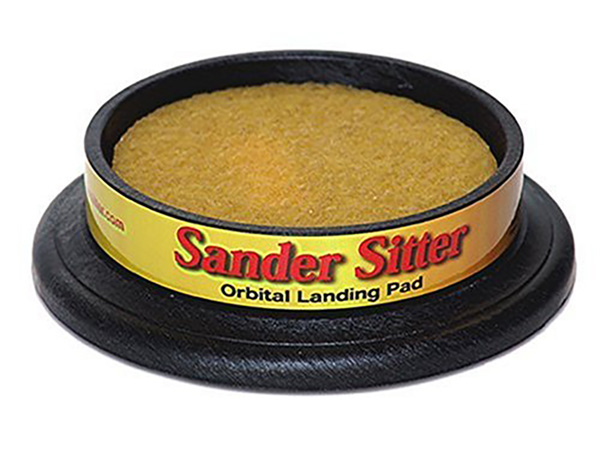
When a new product suddenly catches on, it’s often declared the right product at the right time. But the Sander Sitter would have been the right product at any time. It just needed Marty Black to invent it.
The Sander Sitter provides the one safe place you can set a running 5-1/2″ orbital sander and not have it jumping off your workbench. And while its carousel tray spins along with the sander, its crepe rubber pad cleans the sandpaper.
“It all began five years ago when I took early retirement from a telecommunications company,” Marty explained.
Living on a farm near Baxter village in Ontario, he’d had a small woodshop business on the side for 20 years and now he could put full time into it. Working with his artist wife, they made decorative, craft-based furniture. He soon tired of his orbital sander taking off and winding up in the garbage can, and one busy night he had a brainstorm. “After just ten minutes of building, I had the first wooden version,” he recalled. “And darned if my sander didn’t just sit in there and spin. People who saw it laughed at first, but then after a better look, thought it was pretty neat.”
Three years passed, and it gradually dawned on Marty that he ought to do something with this thing?before somebody else did. In the fall of 1999, he decided to make his move. Using ABS sewer pipe, a plastic welder and MDF (medium density fiberboard) for a base, he and some friends decided to build and sell them at a local woodworking show in nearby Toronto. The hardest part was sourcing the crepe rubber needed to clean the sandpaper. It’s usually sold only in thick sticks for belt sanders, but Marty needed flat sheets. With just six days to go, he found a source. Putting all the ladies in his neighborhood to work, he ended up with 300 finished Sander Sitters.
Despite being relegated to the show parking lot, intermittent rain, and using a horse trailer as his booth, demonstrations of Marty’s invention consistently attracted crowds of up to 50 people. After selling 30 machines at $25 a pop and being approached by a local store, Marty had a gut feeling the Sander Sitter was ready to take off. With no background in running a business, but getting good advice from friends, he made three important decisions: go for a patent, put together a demonstration video, and show the device at a real woodworking show against real competition. In most cases, promised shares in the fledgling company paid for the services.
Just six week after that first local show, the Sander Sitter took that national show by storm and Marty sold 75 more. But to then move into a larger market, hand-cut sewer pipe wouldn’t do. Marty set to work creating real packaging, labeling, manufacturing processes, and marketing. Everything from the tolerance of ball bearings and the injection molds had to be negotiated, but three months later a new Sander Sitter rolled out.
It sold well at wood shows, but Canadian distributors were reluctant to take a chance. Because they always wanted to know how many had already sold in the United States, Marty turned his sights south. He hooked up with TWC, and together they showed the product at a September 2000 wood show in St. Louis. When he got back home, there was a call waiting for him from Jim Frey at Rockler Woodworking and Hardware . The company wanted to be the first to retail the product. After it appeared on the back cover of Rockler’s Christmas catalog, things really got going.
Woodworker’s Journal did a tool announcement, and then Fine Woodworking and Family Handyman published favorable reviews. After the CEO of a scientific instruments company saw the device at a New Jersey show last winter, he asked Marty to develop, of all things, an inoculating turntable version for spinning petrie dishes! Then a successful test in August of 2001, earned the Sander Sitter, a seal of approval and recommendation from the Handyman Club of America. And just last December, Canadian Home Workshop magazine declared it one of the hottest tools of 2001.
“It’s been an incredible learning curve and many sleepless nights.” Marty described, “But I always knew that if an ordinary guy like me recognized the value – everyone would. Now the word is out. We used to put on 10 minutes demonstrations, now people come to us to ready to buy. And we’ve never had one come back.”
It’s a remarkable story. After just two years, the Sander Sitter is sold nationally, coast to coast in both U.S. and Canada.
What’s ahead? The company has a six-inch model in the works and is developing plans for square sanders. Industrial applications are inevitable and there’s a possible entry into the European market.






